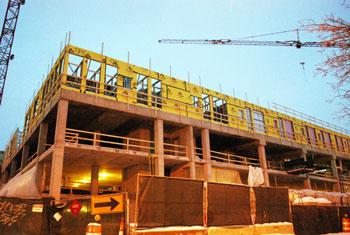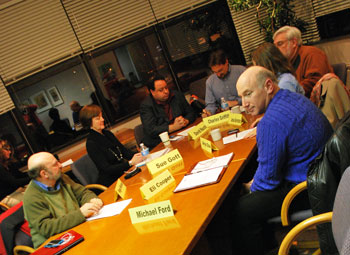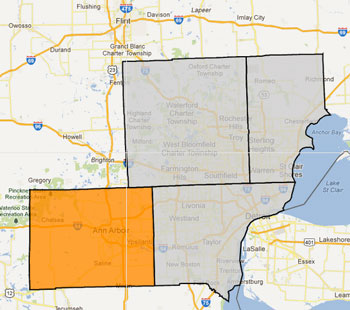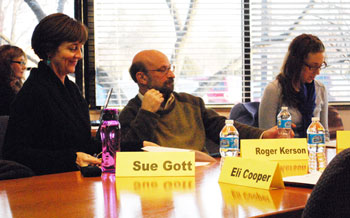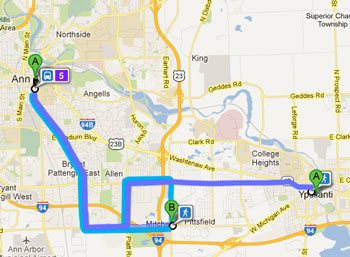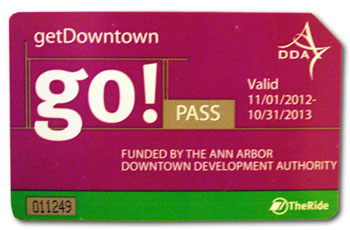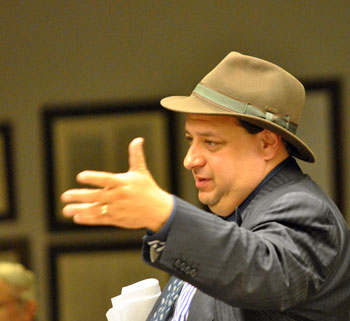Snyder’s Transit Funding: AATA Nods Yes
Ann Arbor Transportation Authority board meeting (Feb. 21, 2013): The board’s meeting was relatively uneventful, but included a routine application for state funding – which this year contains a message of measured support for transit funding in Gov. Rick Snyder’s proposed budget.

From right: Before the Feb. 21, 2013 meeting of the AATA board, Terry Black (manager of maintenance) and Eli Cooper (AATA board member) inspect the construction site of the new Blake Transit Center on Fifth Avenue in downtown Ann Arbor. It’s using an earth retention system similar to that used for the construction of the underground Library Lane parking garage located across the street – but on a much smaller scale. (Photos by the writer.)
The resolution approved by the board includes the AATA’s view that “an increased level of state transit funding such as has been proposed by Governor Snyder would assist AATA in maintaining existing service and operating expanded transit service to satisfy the expressed public demand …” To increase funding for transportation as a general category by $1.2 billion – including roads, bridges and public transportation – Snyder’s budget would rely on proposed increases to the state’s gasoline tax and to vehicle registration fees.
The Michigan state constitution requires that 90% of all fuel taxes be used to fund the maintenance of streets, roads and bridges designed for motor vehicles that use tires. Part of the remaining 10% can be used to fund public transportation operating expenses. Partly as a function of the overall increase, Snyder’s budget would increase the amount of local operating assistance for transit agencies statewide from around $166 million for each of the past two years to about $181 million.
The AATA’s estimated budget for the next fiscal year (2014) is being reported to the state of Michigan as totaling $33,653,000. Those total expenses would be covered by the following breakdown of revenue estimates: federal funds ($4,276,104); state funds ($9,939,035); local funds ($12,088,861); fare revenue ($7,258,000); and other funds ($91,000). The AATA’s current year’s budget – for FY 2013, which ends on Sept. 30 – calls for $32,700,181 in expenditures.
The AATA’s portion of the $166 million in state operating assistance last fall took an unexpected roughly $800,000 dip around the time the AATA set its budget for the current fiscal year. The reduction in funding relates to the way the state’s formula applies when spending is reduced by other transit agencies in the AATA’s category. AATA CEO Michael Ford told the board at its Feb. 21 meeting that he’d been to Lansing and had received assurance that an additional appropriations bill – which is currently the “placeholder” bill SB 126 – is likely to be passed, and would restore the $800,000.
Meanwhile, the most recent financial update through the first four months of the 2013 fiscal year – which started in October – shows the AATA with a slight positive variance. But the AATA is operating with a level of cash reserves that equates to about 2.88 months of operating expenses. Board policy is to keep a minimum of 3 months’ worth reserves on hand. Notes to the treasurer’s report indicate that for the year, the AATA now expects about $160,000 less in fare revenues that it had budgeted – based on fewer rides being taken by University of Michigan affiliates than the AATA had projected.
Besides authorizing the application to the state of Michigan for state operating assistance, the board authorized two contracts in connection with construction on the new downtown Ann Arbor Blake Transit Center – one for the elevator and the other for millwork. Both contracts were under the project’s budgeted amount for those items.
The board also approved a contract for the printing of its RideGuide, a printed version of its schedules. Also authorized was a contract to perform environmental cleanup from a gas line that had been seeping at the AATA’s facility on South Industrial Highway.
Updates at the meeting included notes on the board’s upcoming retreat, which is to include a discussion of AATA customer needs. That led to comments from the public asking the board to think about who the AATA’s customers actually are.
During the meeting, the board also held a closed session to conduct a performance review for CEO Michael Ford. [Full Story]




